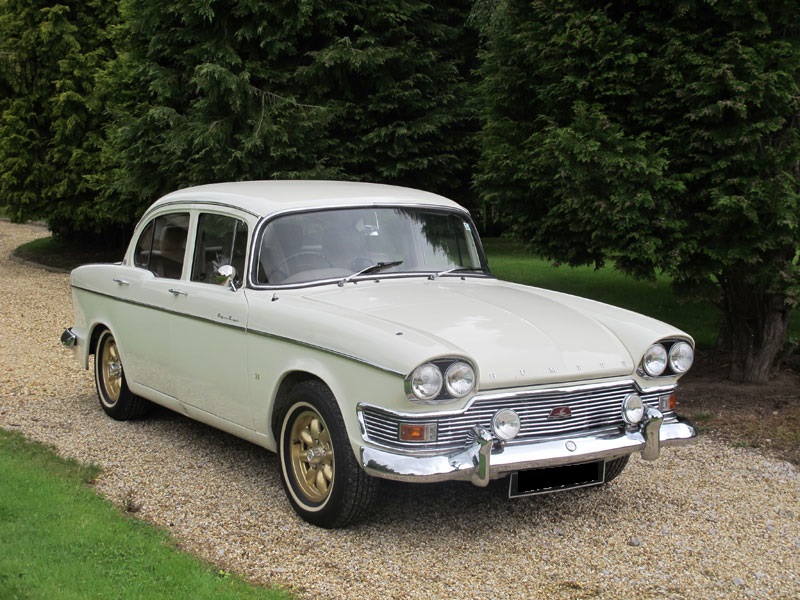-
Insurance
InsuranceAbout our productsLearn about insuringGet a quote Get current values, historical values, model history and more.
-
Valuation
ValuationHagerty valuation toolLook up a vehicle value Get current values, historical values, model history and more.
-
Events
EventsHagerty official eventsHagerty ClubhouseEvent calendar
-
Entertainment
EntertainmentMore to explore
- Portal login
1956 Humber Super Snipe
IV 4dr Saloon 4.1 L
Vehicle values by condition
Fair
Condition 4
£3,100
#4 cars are daily drivers, with flaws visible to the naked eye. The chrome might have pitting or scratches, the windshield might be chipped.
Good
Condition 3
£6,700
#3 cars could possess some, but not all of the issues of a #4 car, but they will be balanced by other factors such as a fresh paint job or a new, correct interior.
Excellent
Condition 2
£9,000
#2 cars could win a local or regional show. They can be former #1 cars that have been driven or have aged. Seasoned observers will have to look closely for flaws.
Concours
Condition 1
£11,500
#1 vehicles are the best in the world. The visual image is of the best car, unmodified, in the right colours, driving onto the lawn at the finest concours.
Insurance premium for a
1956 Humber Super Snipe IV 4dr Saloon 4138
valued at £6,700
£106.41
/ year*
History of the 1953 - 1957 Humber Super Snipe

1953 - 1957 Humber Super Snipe
The Humber Super Snipe Mk IV is an imposing (no less a word will suffice) six-seat, chassis-built saloon. The central hull was from the 1950 Humber Hawk Mk IV, but an elongated bonnet and boot extended the Super Snipe’s overall length to 16ft. 5ins. Unlike its Super Snipe Mk III predecessor, power was from a Commer lorry-derived 4.1-litre I-6 OHV engine with independent, coil springs at the front and a live rear axle with semi elliptic leaf springs.
The Mk IV first appeared in October 1952 and was available as either a saloon for £1,491, or a touring limousine; the latter having a sliding glass division. In December of that year the Rootes Group, who were masters of publicity, devised a plan of having Stirling Moss drive a new Super Snipe from Oslo to Lisbon in just 90 hours.
In 1955 the Humber’s semaphore trafficators were replaced by flashing indicators and Laycock-de-Normanville overdrive became an optional extra. Borg Warner automatic transmission was offered in the following year and the Mk IV was discontinued in 1957. The next Super Snipe would not debut until 1958 and that would be a completely different 3-Litre saloon with a new monocoque body.
The Humber Super Snipe Mk IV’s engine is the Rootes’ 4138cc ‘Blue Riband’ unit and the standard gear change is an all-synchromesh four speed steering column shift. The overdrive operates on the top two ratios and the automatic box does enhance the big Humber’s appeal.
The Mk IV’s lack of power steering is certainly evident at low speeds and the 4-on-the-column needs a certain degree of understanding. That said, the mighty Humber feels incredibly solid and is a car that laughs in the face of pot holes; the ground clearance is largely due to Rootes’ major export market being Australia. The top speed is 91mph in manual form and a well-maintained Super Snipe will still feel primed for travelling across continents. There is an excellent view from the front bench but reclining back rests were an extra and these do afford more comfort. One point of warning for the would-be restorer is that aside from the rarity of the Mk IV and inevitable corrosion challenges, the Super Snipe’s suspension and chassis components are not interchangeable with the Hawk.
The Super Snipe Mk IV is a motor car on a grand scale, from the vast boot to the tall bonnet. And, this is the Humber that scored a class victory in the 1953 Redex ‘Around Australia’ trial so in well-maintained form it will give you reliable transport in leather trimmed comfort.
A Humber Super Snipe Mk IV owner might have also considered the smaller Wolseley 6/80 or 6/90, or possibly a Rover P4 in 90 or 105R forms. Possibly the Humber’s closest rival was the Austin A125 Sheerline.
Hagerty Newsletter
Get your weekly dose of car news from Hagerty UK in your inbox

ADVERTISEMENT